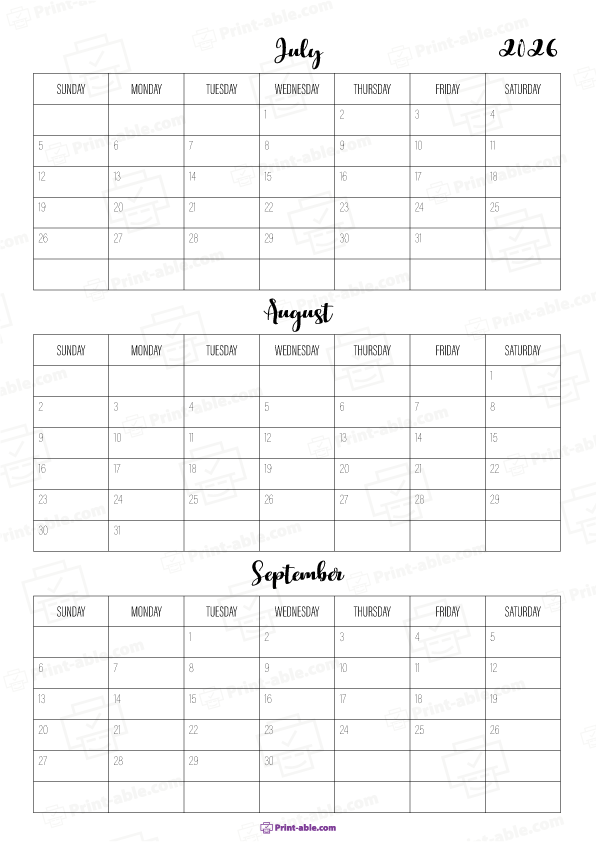If you need July to September 2026 Calendar, you can download and print this PDF. It’s useful for both work and home. The calendar is designed to fit A4 paper (8.2 x 11.6 inches) and is oriented horizontally.
July to September 2026 Free Download




How to print this calendar
To print this calendar, first download the PDF file to your computer. Open the file using a PDF viewer like Adobe Acrobat Reader. Once open, select the ‘Print’ option from the file menu. Ensure your printer is set to use A4 sized paper (8.2 x 11.6 inches) and choose the landscape orientation. Finally, click ‘Print’ to get your physical copy of the calendar.

Overview of July to September 2026 Calendar
The period from July to September 2026 includes various important dates, notable holidays, and observable seasonal changes. Here’s a detailed look into what each month and season holds.
Monthly Calendars
July 2026:
- Begins on a Wednesday and has 31 days
- Contains several notable events including the American Independence Day on July 4
August 2026:
- Starts on a Saturday and runs for 31 days
- Known for the end-of-summer vacations and festivals
September 2026:
- Begins on a Tuesday with 30 days
- Marks the start of autumn on September 23
Important Dates and Holidays
July 4: Independence Day (USA) – Celebrations include parades, fireworks, and barbecues.
July 14: Bastille Day (France) – Marked by fireworks, parties, and historical reenactments.
August 12: International Youth Day – Events and activities centered on youth issues and engagement.
August 19: World Humanitarian Day – Recognizes aid workers and promotes humanitarian causes.
September 5: Labor Day (USA) – Observing workers’ achievements, typically with parades and picnics.
September 23: Autumnal Equinox – The first day of fall in the Northern Hemisphere.
Seasonal Changes and Observations
July and August are typically the hottest months in the Northern Hemisphere, characterized by long days and short nights. July brings peak summer activities, while August often signifies the winding down of summer holidays.
In September, you’ll notice the transition from summer to autumn. This period includes falling temperatures, shorter days, and longer nights. Leaf-peeping becomes popular as foliage begins to change colors, especially in the latter half of the month.
Time Management and Planning Tips
Effective time management between July and September 2026 is crucial for maximizing both individual and team productivity. Focus on seasonal opportunities, transitioning activities, strategic individual planning, and efficient teamwork techniques.
Maximizing Summer Opportunities
Summer offers unique opportunities to blend relaxation with productivity. Identify key goals for the season, setting specific, measurable targets. Balance work and leisure to recharge and maintain energy levels. Use outdoor activities and summer events for team building and networking. Create a flexible schedule to accommodate longer days and unpredictable weather, ensuring you take advantage of both sunny days and down-time.
Transitioning into Autumn
As summer ends, shifting focus towards autumn requires adaptive planning. Adjust your daily routine to shorter days and cooler weather. Prioritize tasks that benefit from autumn’s energy, such as academic projects and financial planning. Review and refine goals set earlier in the year, aligning them with the coming months. Integrate indoor activities to maintain productivity and stay motivated.
Advanced Planning Strategies for Individuals
Developing personal strategies involves a structured approach. Utilize digital tools like calendars, to-do lists, and reminder apps to streamline your schedule. Set clear priorities by distinguishing between urgent and important tasks. Break down larger projects into smaller, manageable tasks to avoid feeling overwhelmed. Reserve time for self-care and hobbies to maintain a balanced lifestyle.
Organizational Planning Techniques for Teams
Team efficiency hinges on effective planning techniques. Implement regular check-ins and updates to ensure alignment on goals and progress. Use collaborative tools such as project management software and shared calendars to enhance communication. Delegate tasks appropriately, leveraging individual strengths to maximize team efficiency. Foster a collaborative environment by scheduling regular team-building activities and feedback sessions.
